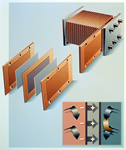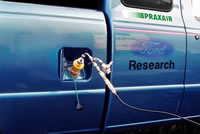
![]()
 A fuel cell converts the chemical energy in hydrogen and oxygen into direct current electrical energy by electrochemical reactions. Fuel cells are devices that convert hydrogen gas directly into low-voltage, direct current electricity. To use a fuel cell in an automobile, the power for the auto comes from an electric motor. The fuel cell supplies direct current electricity. All of the major automobile companies now have either a fuel cell or internal combustion engine powered by hydrogen. Hydrogen can be used as the fuel for both internal combustion engines and fuel cells. If you're interested in learning more about hydrogen utilization or fuel cells, please visit our Hydrogen Basics.
A fuel cell converts the chemical energy in hydrogen and oxygen into direct current electrical energy by electrochemical reactions. Fuel cells are devices that convert hydrogen gas directly into low-voltage, direct current electricity. To use a fuel cell in an automobile, the power for the auto comes from an electric motor. The fuel cell supplies direct current electricity. All of the major automobile companies now have either a fuel cell or internal combustion engine powered by hydrogen. Hydrogen can be used as the fuel for both internal combustion engines and fuel cells. If you're interested in learning more about hydrogen utilization or fuel cells, please visit our Hydrogen Basics.
FSEC has been researching how hydrogen can be used in a variety of ways including vehicles. The following is a list of hydrogen fuel cell and utilization research projects that are going on at FSEC.
High Temperature, Low Relative Humidity Membrane Fuel Cell Program
FSEC’s fuel cell researchers are presently operating and managing the U.S. Department of Energy’s (DOE) $19 million High Temperature, Low Relative Humidity Membrane fuel cell program. DOE has funded 12 projects aimed at advancing membrane durability and extending shelf-life while bringing down the cell’s costs. As the program lead, FSEC is coordinating these projects and playing a key role in directing the efforts of the other participating universities in developing membranes that will allow hydrogen to create electricity to power vehicles.
This program involves overseeing the activities of a High Temperature, Low Relative Humidity Membrane Working Group that includes researchers from the national laboratories, Arizona State University, Case Western Reserve University, Clemson University, Colorado School of Mines, FuelCell Energy, General Electric, Giner Electrochemical Systems, Pennsylvania State University, the University of Tennessee and Virginia Tech. The working group’s research agenda is to prepare and evaluate new membranes for proton exchange membrane (PEM) fuel cells.
For the DOE project, FSEC’s research team will prepare and evaluate new polymeric electrolyte phosphotungstic acid composite membranes to solve the temperature problem. FSEC researchers working with the fuel cell community will also develop standardized experimental methodologies to measure conductivity as a function of relative humidity and mechanical properties of membranes; characterize mechanical, mass transport and surface properties of the membranes, and predict durability of the membranes and their membrane electrode assemblies fabricated by the team for both the in-house research program and for membranes provided by the High Temperature, Low Relative Humidity Membrane Working Group members.
FSEC will also provide the working group with standardized tests and methodologies and short course education offerings on test methodologies along with membrane electrode assembly fabrication techniques so that at the end of three years all members of the Group will be able to perform this work in their own facility. An easily implemented protocol and rapid test apparatus for evaluating the through-thickness conductivity (or resistance) of membranes over a broad range of conditions will be developed. This project is funded by the U.S. Department of Energy.
Development of High Temperature Proton Exchange Membrane Electrolytes
This project is endeavoring to improve the power density of fuel cells, so that they may be better able to serve as primary and auxiliary power sources on aircraft and ultimately spacecraft. Liquid electrolytes need a matrix, and thus materials were sought to hold the solution in place between the electrodes. While the traditional silicon carbide was clearly one of the better materials, hexagonal boron nitride, h-BN, became a strong contender, due to its chemical inertness and fine particle size. Its lubricity also was a positive factor in applying thin dispersions to an electrode surface. Conductivities in excess of those for NafionÒ proton exchange membrane at the same temperature were obtained. Another strong effect has been acid electrolyte concentration. While intuition would suggest that the higher the acid concentration, the higher the conductivity, the results show a maximum in a conductivity/concentration plot, typically around 50% of the saturated value. This effect underscores the need for water to act as a weak base and accept a proton from an acidic species in order for the acid to have functionality. Water also affects the role that hydronium ions play in aqueous acid conductivity. This effect has spawned a new research direction in evaluating the feasibility of operating fuel cells at the maximum conductivity concentration of the acid. This project was funded by NASA.Development of High-Temperature, Proton-Conducting, Solid Electrolytes
Hydrogen is most ideally obtained from water, and the most efficient
way of obtaining hydrogen from water is via electrochemistry, or electrolysis.
A prime component of the electrochemical cell is the electrolyte. Performance
enhancements in electrolytic or galvanic modes may accrue if the cell
can be operated at elevated temperature. More often than not, however,
the electrolyte is the first component to deteriorate, limiting performance
lifetime. Therefore, we undertook a materials development effort where
we attempted to prepare solid electrolytes that have high proton conductivity,
low electronic conductivity, and high thermal, hydrolytic, and electrolytic
stability. This project is funded by NASA.
Hydrogen for Internal Combustion Engines
 |
| Hydrogen/natural gas fueling (HYTEST fuel) of Ford Ranger, FSEC H2 Lab (Photo: S. Spencer) |
|---|
FSEC staff have conducted major work on use of hydrogen as a fuel for internal combustion engines (ICE). The hydrogen fuels program involved the use of an engine dynamometer test laboratory that was used to examine the mixing of hydrogen with natural gas to improve engine performance and lower engine emissions. Researchers began the work by blending low amounts of hydrogen (5 to 10 percent) with natural gas. But, results showed that mixtures of more than 20 percent hydrogen would be required to achieve desired emission reductions. The work focused on a mixture of hydrogen-enriched natural gas that allowed for an extended “lean burn limit” and thus, lower engine emissions, without using a catalytic converter. Results showed that using a 30 percent hydrogen-enriched methane mixer could lower nitrogen oxide emissions by approximately 90 percent in comparison with a gasoline-powered car. FSEC named the hydrogen-methane mixture “HYTEST™” (any hydrogen-methane fuel with hydrogen content greater than 20 percent) and received a patent on the fuel.
Following the engine tests, staff converted a Ford Ranger truck and Chrysler Minivan to operate on HYTEST™. These tests showed HYTEST™ to be the cleanest practical automotive fuel known, producing fewer harmful emissions than even utility grid-recharged electric vehicles. Additional tests showed that HYTEST™ increased automotive engine efficiency.
